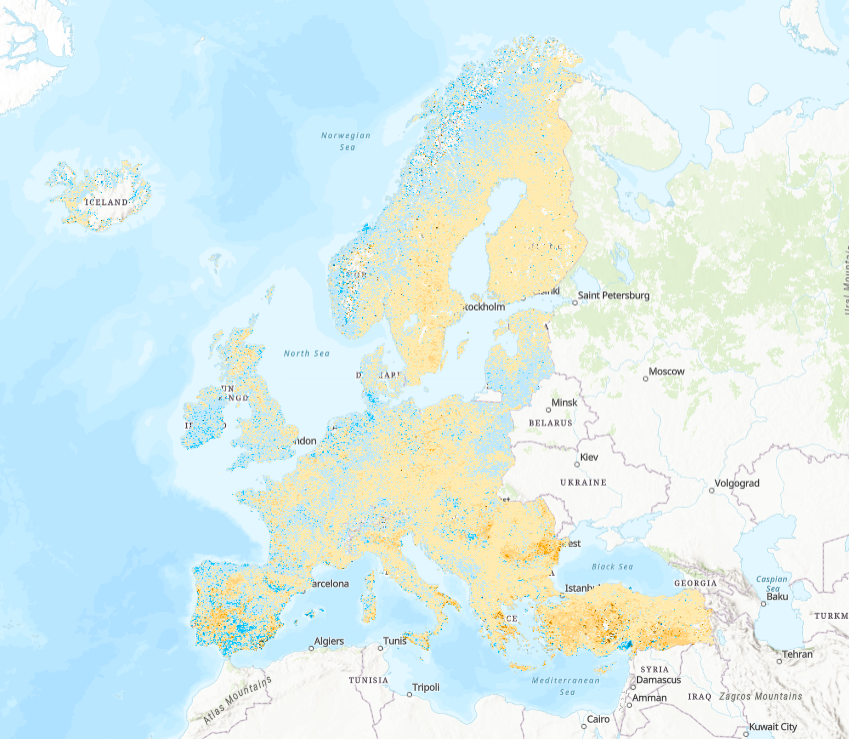trend
Type of resources
Available actions
Topics
INSPIRE themes
Keywords
Contact for the resource
Provided by
Years
Formats
Representation types
Update frequencies
Resolution
-

The raster file is the temporal trend in the start of the vegetation growing season. The start of growing season dataset is based on the time series of the Plant Phenology Index (PPI) derived from the MODIS BRDF-Adjusted Reflectance product (MODIS MCD43 NBAR). The PPI index is optimized for efficient monitoring of vegetation phenology and is derived from the source MODIS data using radiative transfer solutions applied to the reflectance in visible-red and near infrared spectral domains. The start of season dataset is based on calculating the start of the growing season from the annual PPI temporal curve using the TIMESAT software. Change in the start of growing season was then calculated after fitting a linear trend and extracting the slope of the trend. Negative values refer to earlier start of the vegetation growing season, whereas positive values refer to later start of the vegetation growing season.
-

This dataset represents the observed trend in maximum annual five day consecutive precipitation over Europe, between 1960 and 2015, during the winter season (December, January, February). Heavy precipitation events have become more intense and more frequent in Europe on average, but there are important differences across regions, seasons, time periods, heavy precipitation indices and underlying datasets. Studies generally agree that heavy precipitation has become more intense in northern and north-eastern Europe since the 1950s, even though not all changes are statistically significant. Different studies and indices show diverging trends for south-western and southern Europe. Heavy precipitation may lead to local surface water flooding in cities, therefore should be considered in adaptation planning. This dataset is used also in the EEA Indicator "Heavy precipitation in Europe": https://www.eea.europa.eu/data-and-maps/indicators/precipitation-extremes-in-europe-3/assessment, which in the meantime has been updated.
-

This gridded dataset represents the observed trend in maximum annual five day consecutive precipitation over Europe, between 1960 and 2015, during summer (June, July, August). Heavy precipitation events have become more intense and more frequent in Europe on average, but there are important differences across regions, seasons, time periods, heavy precipitation indices and underlying datasets. Studies generally agree that heavy precipitation has become more intense in northern and north-eastern Europe since the 1950s, even though not all changes are statistically significant. Different studies and indices show diverging trends for south-western and southern Europe. Heavy precipitation may lead to local surface water flooding in cities, therefore should be considered in adaptation planning. This dataset is used also in the EEA Indicator "Heavy precipitation in Europe": https://www.eea.europa.eu/data-and-maps/indicators/precipitation-extremes-in-europe-3/assessment, which in the meantime has been updated.
-

The raster file is the temporal trend in above ground vegetation biomass productivity. The vegetation productivity dataset is based on the time series of the Plant Phenology Index (PPI) derived from the MODIS BRDF-Adjusted Reflectance product (MODIS MCD43 NBAR). The PPI index is optimized for efficient monitoring of vegetation phenology and is derived from the source MODIS data using radiative transfer solutions applied to the reflectance in visible-red and near infrared spectral domains. The productivity indicator is based on calculating the area under the PPI temporal curve above the baseline (large integral - LINT) using the TIMESAT software. Relative change of vegetation productivity was then calculated as (YfitLINT2016 – YfitLINT2000)/YfitLINT2000 and expressed in percent scale [%]. Negative values refer to decrease in vegetation productivity, whereas positive values refer to increase in vegetation productivity.
 RUC Geo-Data catalogue
RUC Geo-Data catalogue